Alaska Science Camps, Fairs & Experiments
ANKN is a resource for compiling and exchanging information
related to Alaska Native knowledge systems and ways of knowing. We
are pleased to create and distribute a variety of publications
that assist Native people, government agencies,
educators and the general public in gaining access to the knowledge
base that Alaska Natives have acquired through cumulative experience
over millennia.
TO ORDER THIS PUBLICATION:
Contact the ANKN
offices at 907-474-1902 or email uaf-cxcs@alaska.edu. 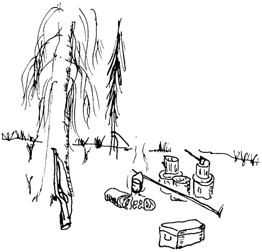 Firestarting Firestarting
Everyone who has spent time out in the
woods in Alaska has relied heavily on the ability to make a campfire.
This isn't much of challenge when the weather is good and conditions
favorable. However, the times we need a fire the most, when we are
wet and cold, sometimes freezing, are the times when it is much more
difficult to start a fire. There are times when firestarting skills
are a matter of life and death. You look at your fingers holding the
match, tell them to move, and nothing happens.
The best time to learn hard things is during easy times. If we are
in a desperate situation we don't have the resources and time to
experiment and learn. Now is the time to do a little science
that might save us later.
Three steps to firestarting
- Matches, lighter, or other methods
- Kindling
- Firewood
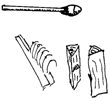 To
get the large pieces of wood burning, we must first get the smaller
kindling burning. To get the kindling burning we need a match or
lighter. To
get the large pieces of wood burning, we must first get the smaller
kindling burning. To get the kindling burning we need a match or
lighter.
Matches
Matches have two parts, the head and the body. The match head is
made of chemicals that ignite at low temperatures. By rubbing the
match against a high friction striker, enough heat is produced to
ignite the chemicals.
The bodies of most matches are either wood or paper.
Lighters
|
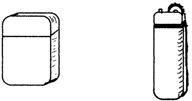
|
|
FLUID
|
BUTANE
|
There are two kinds of lighters, those with liquid fuel and those
with gaseous fuel, like butane.
Most lighters ignite the fuel by a spark from a steel wheel
spinning against a piece of flint.
Some people use magnesium strikers in place of a match. Simply
scrape some magnesium into the tinder, then strike the magnesium with
a knife blade, forcing sparks onto the magnesium chips. A hot flame
is immediately present.
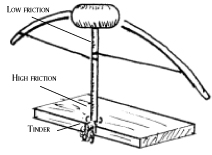
Traditional methods
Traditionally fire was made with a bow and drill or flint and
steel offered in trade. The secret of such a firestarting effort is
in the tinder. The bow and drill create enough heat by friction to
get the tinder glowing. It is easy to make smoke, but another whole
story to turn the embers into a flame. The type of tinder used varied
from region to region. Tinder must be kept very dry. See the next
chapter for details.
 Kindling Kindling
There are different kinds of kindling. Kindling burns hot and
fast. It doesn't last long, but its heat is enough to get the bigger
pieces of wood burning.
Birchbark
The loose bark on the outside of a birch tree is one of the best
materials to get a fire going.
Paper
Dry paper and cardboard are also adequate to ignite small
branches.
 Spruce
pitch Spruce
pitch
In Southeast Alaska, where there is lots of rain, pitch from the
spruce trees is the only effective firestarter. It burns hot and
long, giving damp kindling a chance to dry out and ignite.
Spruce Branches
The dry underbranches of a spruce tree are excellent kindling. The
fine tips of the branches are easily lit by birchbark, and burn with
enough heat to get much larger branches burning. We take small spruce
branches and bark into the tent at night when it is raining. They are
dry for the morning fire.
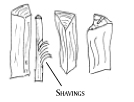 Split
spruce and shavings Split
spruce and shavings
When weather has soaked the birchbark and underbranches of a
spruce tree, a good way to make a fire is to chop sections of drywood
and make shavings and small splinters of wood from the dry inner part
of the tree. Knowing how to do this has saved lives during winter
storms when ice and snow cling to every branch.
Dry branches from willow and
alder
Willow and alder branches don't have the potential heat that dry
spruce branches do, but they are adequate when there is nothing else
available.
Gasoline
Some people start fires with gasoline. This is very
dangerous and should never be done! It is particularly
dangerous when the first effort hasn't succeeded, and fresh gasoline
is poured on smouldering embers. Some people dip a stick in a gas
tank, and light that. That is safer, but still far too dangerous.
Firewood
Firewood provides the heat to boil the coffee, cook meals, dry the
clothes and warm our cold bodies. Larger pieces of wood burn longer
and slower. Smaller pieces burn faster.

Foraging for firewood with an axe is much harder. If the wood is
long and thin, we often break it between two healthy trees rather
than chopping it.
Having a chainsaw available really makes a difference.
Whole dry
trees can be cut up and used. Cutting blocks of wood with the
chainsaw then splitting the inside portions insures dry pieces of
wood when it is raining. Before chainsaws, we used swede saws. They
are light and easy to carry, cutting fast if they are
sharp.
|
Choosing a site for a
fire
We usually make a driftwood fire on a sandbar during the
summer because the wind on the river helps to keep the
mosquitoes away. During the rest of the year, we try to find
a patch of timber that will have adequate kindling and
firewood to last the night.
|
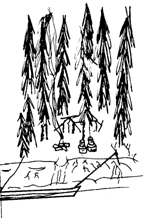
|
Matches and Lighters
Test different kinds of matches, wooden and paper. Which kind
ignites kindling more consistently? Which kinds are better in damp
conditions? When they are damp, do some of the strikers tear apart
before all the matches are used?
 Look
at a paper match under a magnifying glass. Is there a chemical on the
body of the match, close to the head that helps the paper burn? Look
at a paper match under a magnifying glass. Is there a chemical on the
body of the match, close to the head that helps the paper burn?
Hold a lit match with the tip up. Hold it with the tip down. Which
way does it burn faster?
Store matches in different containers, Zip-Lock bags, metal boxes,
your pocket, etc. Dip wooden matches in wax. During a camping trip,
experiment to find the container that keeps matches the dryest.
Test different striker materials for wooden matches. Which work
best?
Try a liquid fuel lighter and a butane lighter when it is very
cold or put them in the freezer. Which one burns the strongest when
cold? Would you carry a butane lighter in the winter? If so, where
would you store it?
Compare the heat of the flame of a wooden match to the flame of a
lighter. Test by trying to light slightly damp paper. Which is
hotter? Which is preferable in camp away from home?
Kindling
Experiment with the different kinds of kindling: birch bark,
paper, shavings, etc. Which ignites the quickest and gets the bigger
wood burning? Why? Which is the easiest? Do not try gasoline.
Many young people have been seriously burned doing this. My son's
friend spent a long painful time in the hospital after they
mishandled gasoline.
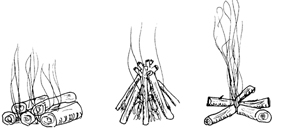 Firewood Firewood
Test the different kinds of wood in your area. Which is most
plentiful? Which ignites more easily? Which gives the most heat once
it is burning? Which burns the longest?
Split pieces of wood, and leave others unsplit. Make two nearly
identical campfires, and then put the split wood on one fire, and the
unsplit wood on the other. Which burns hotter and faster. You might
test this by putting a coffee pot of water over each fire and see
which one boils water faster. Use measured amounts of water, and time
the experiment carefully.
 Which
wood is better for campfire, dry spruce, driftwood, birch, willow,
cottonwood, cedar, or alder? Which
wood is better for campfire, dry spruce, driftwood, birch, willow,
cottonwood, cedar, or alder?
Experiment with the way wood is placed in the fire. Parallel,
teepee, crosshatched, etc. Which way burns faster? Which way burns
slower? Which would you use to boil water?
What effect does the flow of air have on the different methods of
placing the wood on the fire? How does this effect the burning rate?
If your are roasting meat or warming yourself, you will build a
different fire. How do fires differ with the needs?
In the chart below, rate the types of kindling from best to worst.
Rate the types of matches/lighters, etc.
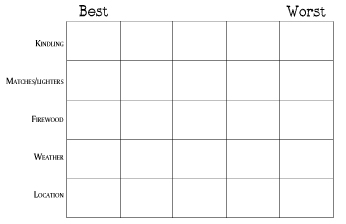
What conclusions do you come to regarding firestarting and the
building of a campfire? What are the applications to your life?
Are you ready to pass the test the next time you are shivering
cold on a boat trip or in the winter when your hands are too cold to
hold a match? Firemaking under adverse conditions is a timeless
Alaskan skill.
Make one fire in a new location. Make another fire with the
charred sticks and logs from a previous fire. Which is easier to
ignite? Why?
Be careful where you make a campfire, often the fire will burn
deep in the moss for days and erupt as a forest fire. One year near
the Canadian border, a fire burned under the snow all winter, and
surfaced in the spring to continue burning the moss.
|